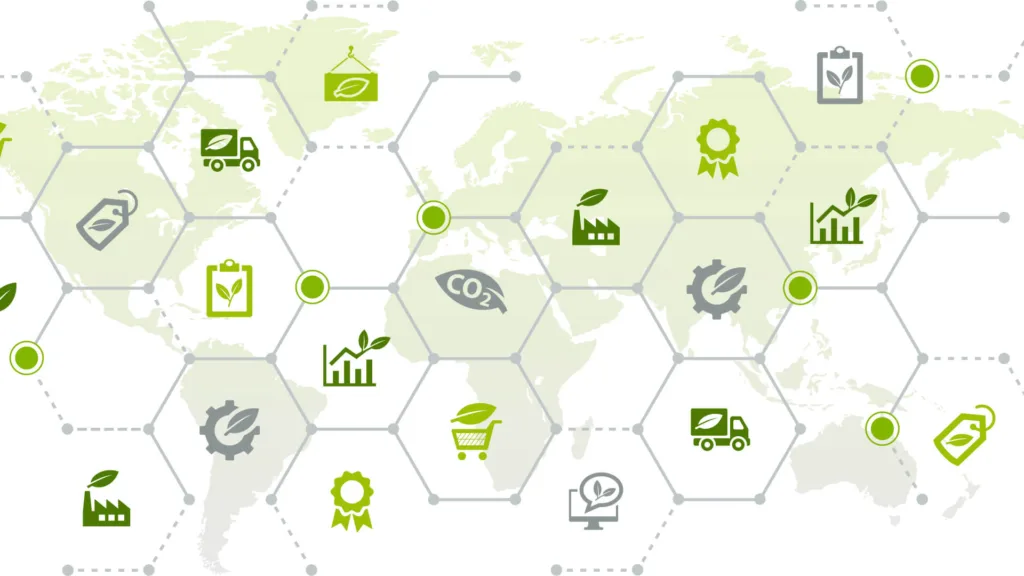Engaging Supply Chains On The Decarbonization Journey

The global race to net-zero emissions has shone a spotlight on the critical role of supply chains in achieving ambitious sustainability goals. Here at Carbonbright, we understand the complexities businesses face in navigating this evolving landscape.
In this blog post, we’ll delve into the importance of supplier engagement for decarbonization, explore key strategies, and provide a roadmap to get you started.
.
Why Supplier Engagement Matters
The vast majority of an FMCG or CPG organization’s carbon footprint often resides within its supply chain (about 90%), categorized as Scope 3 emissions. These emissions, encompassing purchased goods and services (Category 1) and capital goods (Category 2), can be significant. However, due to challenges in measurement and attribution, they often get overlooked in carbon reduction plans.
The tide is turning however, with businesses increasingly being held accountable for transparency across their entire value chain, including Scope 3 emissions. Engaging with suppliers offers a powerful solution for gaining visibility into these emissions sources, identifying improvement areas, and ultimately driving impactful reductions. This collaborative approach fosters not only environmental benefits but also innovation, cost savings, and long-term success.
.
Supplier Engagement
Supplier engagement goes beyond mere emission reduction. It’s a strategic approach that fosters stronger relationships, optimizes operations, and unlocks hidden value. Here’s how effective supplier engagement empowers your business:
- Enhanced Transparency and Accountability: Gain a clear view of your supply chain’s emissions footprint, enabling informed decision-making and responsible sourcing practices. By collaborating with suppliers to establish standardized data collection methodologies, you can ensure the accuracy and reliability of reported emissions data.
- Climate Risk Mitigation and Resilience: By collaborating with suppliers on climate risk assessments, you can build a more resilient supply chain prepared for future disruptions. This might involve jointly identifying potential risks associated with extreme weather events, resource scarcity, or changing regulations, and then developing mitigation strategies to safeguard your operations.
- Brand Reputation and Customer Attraction: Demonstrate your commitment to sustainability, attracting environmentally conscious consumers and investors alike. Responsible sourcing practices that prioritize suppliers with strong sustainability credentials not only reduce your environmental impact but also enhance your brand image.
- Cost Savings and Innovation: Collaboration unlocks opportunities for optimizing processes, reducing waste, and driving innovation throughout the value chain. Working with suppliers to identify areas for material substitution, energy efficiency improvements, or circular economy principles can lead to significant cost reductions and a more sustainable product lifecycle.
- Supplier Sustainability Maturity Assessment: Evaluate your suppliers’ sustainability practices, identify areas for improvement, and foster a two-way dialogue that fuels collaborative innovation. This assessment can reveal opportunities for knowledge sharing and capacity building within your supplier network, ultimately leading to a more sustainable ecosystem.
- Collective Impact for a Sustainable Future: By working together with your suppliers, you can collectively contribute to a more sustainable future for generations to come. Supplier engagement allows you to leverage your collective influence to drive positive change across the entire industry and create a ripple effect that extends far beyond your individual company.
.

.
The Key to Effective Engagement
Supplier engagement can be a multifaceted endeavor. Here are some key strategies to maximize its effectiveness:
- Prioritize Your Efforts: Focus on your most impactful suppliers, targeting those that contribute the most to your Scope 3 emissions. This ensures you optimize your resources and achieve the greatest impact. You can utilize spend data and industry benchmarks to identify these high-impact suppliers.
- Collaboration is Key: Invest in training and knowledge-sharing opportunities to equip your suppliers with the tools and understanding they need to embark on their own decarbonization journeys. This fosters a collaborative environment that tackles challenges head-on. Workshops, webinars, and knowledge-sharing platforms can be effective tools for capacity building among your supplier base.
- Leverage Technology: Utilize digital tools and data management software to streamline data collection, enhance accuracy, and ensure auditability across your organization. Cloud-based platforms can facilitate secure data exchange and real-time progress tracking, as well as measurement of product-level emissions which will help in prioritizing, enabling transparent communication and collaborative decision-making.
- Set targets, track progress: Collaborate with suppliers to set ambitious yet achievable targets, and monitor progress over time. Regular communication and transparent goal setting are essential for maintaining momentum and fostering a sense of shared responsibility.
.
Collaboration for a Sustainable Future
By working together with your suppliers, you can transform your supply chains, reduce emissions, and achieve net-zero goals. You can also enhance supplier relationships, improve brand reputation, and establish yourselves as sustainability leaders within your industry. Additionally, collaboration can lead to unexpected innovations. As suppliers strive to meet your sustainability goals, they may develop new processes or technologies that benefit your entire industry. By joining forces with your suppliers, you can create a ripple effect of positive environmental change throughout your industry.
But where do you start? CarbonBright is here to be your partner on this crucial journey. Our innovative solutions streamline emissions measurement, making supplier engagement a breeze. We help you define shared reduction goals and foster ongoing communication, empowering you to work together with suppliers and translate strategy into impactful action.



